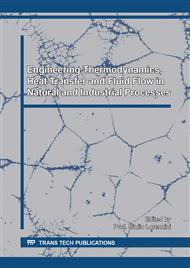p.1
p.14
p.28
p.39
p.44
p.61
p.77
p.96
Flow Analysis of Multiple Injectors in High-Power-Density HSDI CR Diesel Engines
Abstract:
The primary task in DI (Direct Injection) diesel engines design is the fulfilment of the required emission limits. This result should be achieved with acceptable power-to-rpm diagrams, acceptable fuel consumption, acceptable power density and affordable purchase and maintenance expenses. The most common approach to fulfil these requirements is the downsizing. In this case a significant increase in the crankshaft speed and boost pressure is unavoidable. In this way, an improvement in airflow through the redesign of the intake and exhaust geometry is obtained. Unfortunately, duct design is extremely difficult due to “Mach lock”. A further important boundary condition is due the injector inertia. The dynamic response improves with small injectors due to the Newton’s second law. Small injectors designed for unitary power of 15 to 70 HP are extremely common. Therefore, most of the research is centered on these injectors. Furthermore, their small inertia favors better opening and closing time. Nozzles number and position is also greatly influential on combustion performance. The larger surface of the spray reduces the gasification time of the droplets. For these reasons, multiple injectors systems may be used in large high pressure HSDI-CR (High Speed Direct Injection – Common Rail) diesels. Multi injection was commonplace in relatively large old diesels. This paper proposes new intake duct geometries for modern two-injectors-per-cylinder truck-size engines. For this purpose a new promising, patented concept is introduced. The study includes flow simulations during the intake phase. This patented geometry induces the presence of two extremely strong swirls approximately centered to the injectors, with excellent swirl coefficient and high flow rate. The use of swirl generators on the manifolds avoids the necessity to design helical intake ducts. This patented approach simplifies head design. Moreover, using a VG (Variable Geometry) arrangement for the volutes (swirl generators) it is possible to tune the swirl index at the optimum for every crankshaft velocity and every load. In this way, the vehicle fuel consumption is also reduced.
Info:
Periodical:
Pages:
1-13
Citation:
Online since:
October 2018
Authors:
Keywords:
Price:
Сopyright:
© 2018 Trans Tech Publications Ltd. All Rights Reserved
Share:
Citation:


